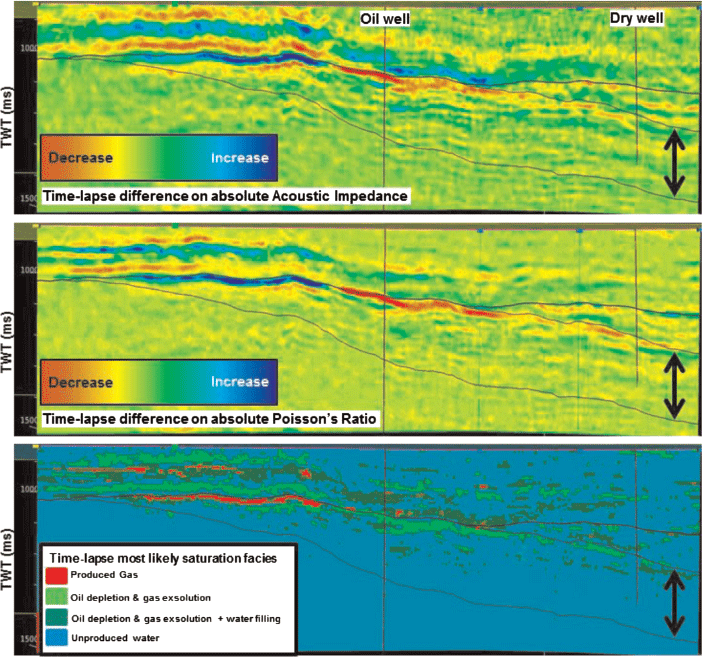Time-lapse seismic monitoring methodologies applied to the Pyrenees Field, offshore Western Australia
Ramses Meza A , Guy Duncan A , Konstantinos Kostas A , Stanislav Kuzmin A , Mauricio Florez A , Tom Perrett A and James Stewart ABHP Billiton Petroleum.
The APPEA Journal 55(2) 412-412 https://doi.org/10.1071/AJ14047
Published: 2015
Abstract
Time-lapse dedicated 3D seismic surveys were acquired across the Pyrenees oil and gas field, Exmouth Sub-basin to map production-induced changes in the reservoir. Rock-physics 4D modelling showed that changes in pore pressure and fluid saturation would produce a time-lapse seismic response of sufficient magnitude, in both amplitude and velocity, to overcome time-lapse noise.
The dominant observed effect is associated with gas coming out of solution. The reservoir simulation model forecasted that reservoir depletion would cause gas breakout that would impact the elastic properties of the reservoir. The effect of gas breakout can be clearly observed on the 4D seismic data as a change in both amplitude and velocity. The analysis of the seismic datasets was proven to be enhanced significantly by using inversion methodologies. These included a band-limited extended-elastic impedance (EEI) approach, as well as simultaneous 4D elastic inversion. These datasets, combined with rock physics modelling, enabled quantitative interpretation of the change in 4D seismic response which was a key tool for assisting with the infill well placement and field development strategy.
Introduction
The Pyrenees HUB consists of an ensemble of discrete oil accumulations that are located in the Exmouth Sub-basin, offshore northwest Australia. The accumulations consist of normal tilted fault blocks truncated by the Intra-Hauterivian unconformity (IHU). The reservoir rocks belong to the Pyrenees member of the Barrow Group (Early Cretaceous). The Pyrenees member in the area is comprised of thick sands packages with high net-to-gross ratio (NTG > 90%), high porosity (~28%) and high permeability (K~3,000–5,000 mD). The dominant hydrocarbon phase is saturated biodegraded oil (19–22° API, GOR 150–190 scf/stb). Three accumulations show clear seismic evidence of gas caps, confirmed by drilling. Three of the accumulations are now being developed using horizontal oil producers. There is good aquifer support and water injection wells are for produced water disposal rather than pressure support.
High seismic amplitudes can be associated with the presence of hydrocarbons, with a number of prominent flat-spots locally observable on seismic data before field development. The biodegraded oil is expected to result in a relatively poor sweep efficiency during field development, yielding potential bypassed oil that is expected to be identified using 4D seismic.
Rock-physics modelling (Kuzmin et al, 2015) has shown that changes in fluid saturation should be observable on time-lapse seismic data. The drop in reservoir pressure will result in gas coming out of solution, identifying unconnected oil volumes on 4D seismic. The effect of gas coming out of solution on the reservoir’s elastic properties would, however, also make it very difficult to monitor the vertical displacement of the fluid contacts.
The 4D seismic monitoring used a time-lapse, dedicated baseline 3D survey acquired in 2006 prior to field development, and a monitoring 3D survey acquired in 2013, three years after the first production. To mitigate tuning-interference effects and obtain better calibration to actual elastic properties, the 4D seismic analysis was performed using both band-limited (relative) impedance and simultaneous absolute pre-stack inversion.
Relative impedance
Time-converted pre-stack depth migrated gathers were used to obtain AVA intercept and gradient volumes for each survey vintage. Colored Inversion (Lancaster and Whitcombe, 2000) was applied to each volume to obtain relative acoustic (AI) and gradient (GI) impedance, respectively. The extended elastic impedance (EEI) approach (Whitcombe et al, 2002) allowed the combination of the AI and GI volumes depending on a rotation angle ç, in such a way to enhance either fluid and/or lithology response as predicted by the rock-physics modelling.
Fig. 1 shows maps of the 3D rendered EEI volumes depicting the three main Pyrenees accumulations under development, with two-way time contours overlaid. The enhanced hydrocarbon responses (hereafter EEI30) at ç = 30° are shown for the baseline (left) and monitor (centre). The time-lapse difference (monitor minus baseline) is shown on the right. Blue shows areas where reservoir compressibility has increased, which correspond to where the original gas caps have being produced and partially replaced with oil; in contrast, red areas show locations where the reservoir compressibility has decreased as the result of gas coming out of solution due to reservoir depletion. These results were used to make inferences about actual sweep efficiency and infill well placement.

|
Simultaneous absolute pre-stack inversion
The same time-converted, pre-stack, depth-migrated gathers were used as input for a 4D simultaneous pre-stack inversion, the goal of which was to obtain volumes of absolute values of acoustic impedance (AI) and Poisson’s Ratio (PR) in a time-lapse basis. The goals of this step were mitigation of tuning effects, better quantification of fluid saturation and reservoir pressure changes. Provided that the inversion is time-lapse based, it is expected that all 4D anomalies observed are due to actual time-lapse changes on subsurface elastic properties.
A drop in reservoir pressure was predicted by the rock physics to cause saturation changes in the oil column, due to the gas coming out of solution. This effect would be observable on time-lapse seismic (Kuzmin et al, 2015). Even though there are also areas where pressure drops cause no saturation changes, these would not yield time-lapse anomalies of a magnitude comparable to those that undergo pressure-driven saturation changes.
Given that three fluid phases are present, a single saturation volume could not be generated. It was decided therefore to pursue a Bayesian classification approach to assign probabilities of occurrence to the saturation facies based on the expected time-lapse differences on AI and PR.
Fig. 2 shows a cross-section across one of the oil accumulations being developed, with two wells drilled before first production is shown. The top and middle views correspond to the time-lapse difference of AI and PR obtained from the simultaneous, pre-stack inversion of each vintage. These show a very weak time-lapse signal around the dry well and stronger signal updip, as expected. The Bayesian classification of saturation facies generated a probability of occurrence of each facies as defined by the statistical rock-physics modelling based on the time-lapse signals on AI and PR. Fig. 2 (bottom) shows one outcome of the classification, with the most likely facies at each space location. It clearly confirms the signature of the produced gas cap (red) and places where gas is coming out of solution in the oil column (light green). As expected, these time-lapse signatures are restricted updip from the dry well. The two other facies are expected to overlap each other; as such, their signature is not conclusive.
Conclusions
Time-lapse dedicated acquisition, processing and analysis of seismic data, constrained by rock-physics modelling, allowed the identification of signatures related to changes in the elastic properties of the reservoir, which are very likely associated to changes on reservoir properties. Gas cap depletion, as well as gas coming out of solution in the oil column, can be identified with a high level of confidence in both relative and absolute inversion outcomes. Spatial interpretation of these signatures, combined with detailed geological context, provides insights about reservoir hydraulic compartments and bypassed oil. This has a large impact on the development strategy and reservoir management, especially on well-placement optimisation and reservoir simulation and forecasts.
References
Kuzmin, S., Florez, M., and Duncan, G.D., 2015—Rock physics modelling and analysis of time-lapse seismic response on Pyrenees field, offshore Western Australia. APPEA Conference, Melbourne, Australia, 17–20 May, extended abstract, DVD.Lancaster, S., and Whitcombe, D., 2000—Fast-track colored inversion. In: SEG expanded abstracts, 1,572–75.
Whitcombe, D.N., Connolly, P.A., Reagan, R.L., and Redshaw, T.C. (2002). Extended elastic impedance for fluid and lithology prediction. Geophysics 67, 63–7.

Ramses Meza obtained his MSc in geophysics from the Colorado School of Mines (USA) and geophysical engineering degree from the Universidad Simon Bolivar (Venezuela). Early in his career he worked as a reservoir geophysicist at PDVSA in Puerto La Cruz, Venezuela; Harvest-Vinccler in Maturin, Venezuela, and ConocoPhillips in Houston, USA. His responsibilities included support in terms of quantitative seismic interpretation for hydrocarbons exploration and production activities. He has been with the BHP Billiton’s Quantitative Interpretation team providing support to all E&P assets with emphasis on integration of QI products, visualisation, seismic attributes and visualisation, QI quality assurance, seismic reservoir characterisation, DHI analysis and risking since 2012. Member: SEG, AAPG, EAGE and SOVG. |

Guy Duncan obtained his PhD in geophysics from Melbourne University. Early in his career he worked as a scientist at BHP ’s research laboratories in Newcastle, Australia. There he was involved in the development of seismic methods for resource exploration and production in the mining industry, such as cross-hole seismic tomography and in-seam seismic methods. Since 1995, he has been with BHP Billiton’s petroleum division, working in various technical roles in a number of geographical locations. The main emphasis of his work has been in seismic imaging, quantitative interpretation, 4D seismic and development geophysics. Member: ASEG, SEG and PESA. |

Kon graduated from Curtin University in 1993 with a BSc in physics and geophysics. He has international experience in exploration and development in the oil and gas industry, a cross-disciplinary skill set and has been exposed to a variety of basins, from land to deep water, throughout Australia and Asia. Kon is now working for BHP as a development geophysicist for the Pyrenees Field Development, offshore WA, and is actively involved in 4D as part of a multi-disciplinary team. |

Stanislav Kuzmin graduated from University of California, San Diego, in 2004 with a PhD in physics and worked on a variety of exploration and development projects in different basins. He primarily works in quantitative interpretation and rock physics. Stanislav’s responsibilities include support in terms of quantitative seismic interpretation for hydrocarbons exploration and production activities. |

Mauricio Florez has a BSc in geology from the National University of Colombia and a PhD in geophysics from Stanford University. He is now a geophysicist at BHP Billiton Petroleum and manager of the QI Team. He worked as an exploration geologist in Colombia for about eight years, and after finishing his graduate studies in 2005, he has worked in reservoir characterisation (iReservoir), rock physics and AVO modelling (BP America) and, recently, quantitative seismic interpretation with BHP Billiton. |

Tom Perrett received an MSc from Victoria University in Wellington, New Zealand. He has worked in the oil and gas industry for the past 25 years on a diverse set of projects including exploration in Myanmar and China and development projects in Vietnam, the Gulf of Mexico, Trinidad and Australia. He now holds a position as a staff geologist working on development projects off the North West Shelf of Australia. |

James Stewart received a BE and a BSc from the University of Melbourne in Melbourne. He has mainly worked offshore Western Australia, Carnarvon Basin projects, with a focus on moderately heavy-oil developments. James is the reservoir engineer for the Pyrenees project. |



